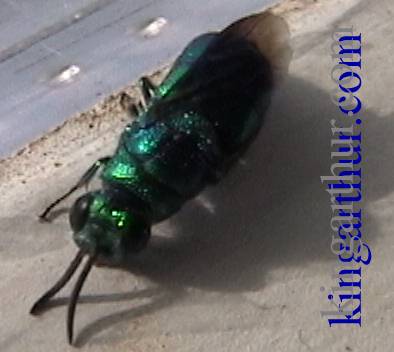Invasion Of The Cuckoo Wasp

Arrival Of The Cuckoo Wasp
“Take the Hogweed which related to the true story in the press at the time about how the plant - Giant Hogweed - imported from Russia in Victorian times had become rampant thru the British countryside.”
– Paul (on Peter Gabriel & Genesis)
Well, I’ve mentioned several such concerns in the past (including the morning glory.)
At least these things are plants. Things with venom and/or stingers are of more interest. Take the cuckoo wasp.
Over the last few years, I’ve come in contact with almost all known poisonous, venomous and/or stinging things in the state of Pennsylvania — rattlesnakes, copperheads, bees, wasps, hornets, poison ivy, sumac and poison oak.
In general, these things are bland in color… beige, olive, greens, browns and grays.
About 3 years ago, I started seeing some strange insects. They were bright metallic looking “flies.” I noticed a couple of them outside and thought it odd that such a tropical looking insect would be around here. Then, last year I noticed more of them. However, it was not until this year that I captured one.
The space I work in has several natural bug traps. About 10 years ago I noticed an increase in the yellow jacket population. The number of yellow jackets appeared to be increasing, as well as, their aggressive behavior. It was about 4 years ago that I started noticing varieties of wasps that I’d never seen.
The first time I saw a “thread waisted” (sphecid wasp) I couldn’t believe it. I thought, “this must be some mutilated or mutated wasp?” (Click here to see a picture of a Thread Waisted Wasp.)
Over the last two years, I watched these populations first increase… and then decrease. The drop in yellow jackets and sphecid wasps actually seems quite amazing… or it did until I found out about that “metallic fly.” (So far this year, three cuckoo wasps have shown up in the “trap.”)
Here are some quotes on the cuckoo wasp:
“Cuckoo Wasp, common name for a group of mostly small, stinging wasps. Cuckoo wasps are brilliant metallic blue, green, or reddish in color. They are parasites that lay their eggs in the nests of bees, wasps, and certain other insects, which are called their hosts. There are approximately 3000 species of cuckoo wasps throughout the world, including about 230 species in the United States and Canada. Cuckoo wasps are also called gold wasps, ruby wasps, and jewel wasps.
Cuckoo wasps are only seen occasionally due to their small size and secretive habits. However, in open, sunny habitats they are often abundant on flowers and small shrubs, where they feed on nectar. Cuckoo wasps often lurk near the burrows of their hosts, waiting for an opportunity to sneak in and lay an egg. They have a thick, hard cuticle (outer covering) that is covered with pits. The cuticle provides protection from stings and strong biting mandibles of host insects, which may attack the cuckoo wasp. In addition, the underside of the abdomen is concave and allows the wasp to roll up into a protective ball, another defensive mechanism. Although cuckoo wasps sting, their stinger is very small. [editor's note: though the actual size of the stinger can be measured in centimeters, proportional to the body size -- it is the longest stinger I've ever seen. I thought the wasp was a fly, until I tried to subdue it.]
Cuckoo wasps can be divided into two chief types based on their lifestyles: parasitoids and cleptoparasites. Parasitoids feed on the larva of the host and cleptoparasites “steal” the host’s food. In both cases the host larva dies. The food-stealing behavior of cleptoparasite species resembles that of the cuckoo bird and gave rise to the cuckoo wasp’s name. Hosts of parasitoid species include bees, sphecid wasps, potter wasps, sawflies, silk moths, and the eggs of stick insects. Cleptoparasitic species feed on provisions of sphecid wasp nests, which may include dead spiders, true bugs, aphids, or thrips.”
I’ve found research that says the cuckoo wasp has been found as far north/east as Pennsylvania (though the closest sighting I could find was in West Virginia. During the last several decades, I’d never seen a cuckoo wasp in Eastern PA.)
summary:
yellow jackets –> sphecid wasps –> cuckoo wasps
This evidence in wasp populations leads me to believe that global warming is causing climatic changes. The climate changes have allowed south/west insect species to migrate north/east. After the populations increase, the next species in the food chain moves in.
